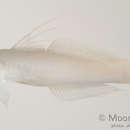Diagnostic Description
provided by Fishbase
Characterized by pale grey body color; yellowish head; bluish curved bar from below eye to opercle (Ref. 2798); thin bluish white bar on pectoral fin base; second to fourth dorsal spines prolonged as filaments in fish larger than about 4.5 cm; rounded caudal fin, longer than head; longitudinal scale series 101-126; ctenoid body scales, becoming cycloid anteriorly below first dorsal fin; head or midline of nape without scales; side of nape with scales extending forward to above or slightly before middle of opercle; fully scaled pectoral fin base and prepelvic area in adult; depth of body 4.5-5.1 in SL (Ref. 90102).
- Recorder
- Cristina V. Garilao
Diseases and Parasites
provided by Fishbase
Metacercaria Infection (Flatworms). Parasitic infestations (protozoa, worms, etc.)
Life Cycle
provided by Fishbase
Distinct pairing (Ref. 56363). Females spawn every 13 days while males guard the eggs which are laid in a burrow for 2-3 days (Ref. 56363). Both sexes impose monogamy as a practise by guarding each other against other possible mates (Ref. 56363). Mate guarding is made possible because all males were able to hold a nest site, both sexes exhibit strong site fidelity, and residents have an advantage in contests over mates (Ref. 56363). Monogamous mating is observed as both obligate and social (Ref. 52884).
Morphology
provided by Fishbase
Dorsal spines (total): 7; Dorsal soft rays (total): 17 - 19; Analspines: 1; Analsoft rays: 16 - 19
- Recorder
- Cristina V. Garilao
Trophic Strategy
provided by Fishbase
Common in clear outer lagoon and seaward reefs, over hard bottoms as well as over sand and rubble. Typical along reef-crests in depths of 1-6 m, but has also been collected from depths of 24 m. Usually seen in pairs, hovering near their burrow. Monogamous (Ref. 52884, 48637). Feeds on small benthic invertebrates, fishes, and fish eggs by sifting mouthfuls of sand.
- Recorder
- Drina Sta. Iglesia
Biology
provided by Fishbase
Common in clear outer lagoon and seaward reefs, over hard bottoms as well as over sand and rubble. Typical along reef-crests in depths of 1-6 m, but has also been collected from depths of 24 m. Usually seen in pairs, hovering near their burrow. Monogamous (Ref. 52884, 48637). Feeds on small benthic invertebrates, fishes, and fish eggs by sifting mouthfuls of sand.
- Recorder
- Estelita Emily Capuli
Importance
provided by Fishbase
aquarium: commercial
- Recorder
- Estelita Emily Capuli

